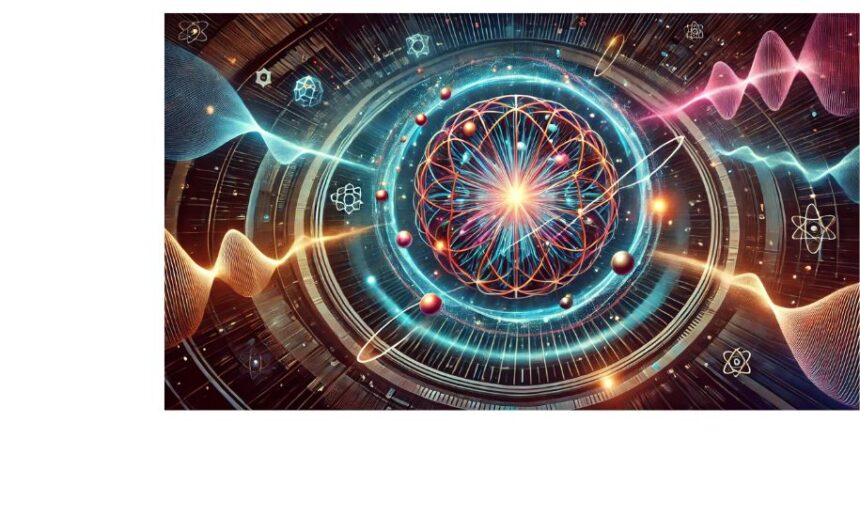Particle Physics, a cornerstone of modern scientific exploration, delves into the fundamental particles and forces that shape our universe. This article by Physics Heaven offers an in-depth look into the intricate world of Particle Physics, exploring the particles, forces, and groundbreaking discoveries that continue to redefine our understanding of the cosmos.
What is Particle Physics?
Particle Physics is the branch of physics that studies the smallest known building blocks of the universe and how they interact. It focuses on elementary particles like quarks, leptons, and bosons, and the fundamental forces—gravitational, electromagnetic, strong nuclear, and weak nuclear—that govern their interactions. Particle Physics seeks to answer profound questions about the origin and composition of matter and energy in the universe.
The Standard Model of Particle Physics
The Standard Model is the theoretical framework that describes the electromagnetic, weak, and strong nuclear interactions. It classifies all known elementary particles into two main groups: fermions (matter particles) and bosons (force carriers). Fermions include quarks and leptons, while bosons comprise particles like photons, gluons, W and Z bosons, and the Higgs boson. Despite its success, the Standard Model leaves several questions unanswered, such as the nature of dark matter and the integration of gravity.
Fundamental Particles in Particle Physics
Quarks and Leptons
Quarks and leptons are the two basic categories of matter particles. Quarks combine to form protons and neutrons, which make up atomic nuclei. Leptons include electrons, which orbit atomic nuclei, and neutrinos, which are nearly massless and interact weakly with matter.
Force-Carrying Bosons
Bosons are particles that mediate forces. For instance, photons mediate electromagnetic force, gluons mediate the strong force, and W and Z bosons mediate the weak force. The Higgs boson, discovered in 2012, is responsible for giving mass to other particles through the Higgs mechanism.
Beyond the Standard Model
While the Standard Model has been remarkably successful, it does not account for phenomena like dark matter, dark energy, and gravity. Theories such as supersymmetry, string theory, and quantum gravity aim to extend our understanding of Particle Physics. The search for particles beyond the Standard Model continues in experiments conducted at large particle accelerators, such as the Large Hadron Collider (LHC).
Particle Accelerators: Tools of Discovery
Particle accelerators are essential tools in Particle Physics, enabling scientists to study particle interactions at extremely high energies. The LHC, the world’s largest and most powerful particle collider, has been instrumental in discoveries like the Higgs boson. By smashing particles together at near-light speeds, researchers uncover new particles and explore the fundamental forces of nature.
Dark Matter and Dark Energy in Particle Physics
One of the greatest mysteries in Particle Physics is the nature of dark matter and dark energy, which together make up about 95% of the universe’s total mass-energy content. Unlike ordinary matter, dark matter does not emit or absorb light, making it invisible and detectable only through its gravitational effects. Discovering the particles that make up dark matter could revolutionize our understanding of the universe.
The Role of Quantum Mechanics in Particle Physics
Quantum mechanics underpins the principles of Particle Physics. It explains how particles exist in probabilistic states and interact through quantum fields. The concept of wave-particle duality and the uncertainty principle are crucial for understanding particle behavior at subatomic scales.
Future Prospects in Particle Physics
The future of Particle Physics holds promise for groundbreaking discoveries. Ongoing research aims to detect dark matter particles, understand neutrino oscillations, and explore the possibility of extra dimensions. Advancements in technology and international collaboration will continue to push the boundaries of knowledge.
Conclusion
Particle Physics stands at the frontier of scientific discovery, unlocking the secrets of the universe at its most fundamental level. Through the dedicated efforts of researchers and institutions, including those highlighted by Physics Heaven, humanity inches closer to answering some of the most profound questions about existence. As Particle Physics continues to evolve, it will undoubtedly shape our understanding of reality in unimaginable ways.
Frequently Asked Questions (FAQs) about Particle Physics
What are the fundamental particles in Particle Physics?
Fundamental particles include quarks, leptons, and bosons. Quarks and leptons form matter, while bosons mediate fundamental forces.
What is the Standard Model in Particle Physics?
The Standard Model is a theory that explains the electromagnetic, weak, and strong nuclear forces and classifies elementary particles.
How was the Higgs boson discovered?
The Higgs boson was discovered in 2012 at CERN’s Large Hadron Collider through high-energy particle collisions.
What is dark matter in Particle Physics?
Dark matter is a mysterious substance that makes up most of the universe’s mass but does not interact with light, making it invisible.
Why are particle accelerators important in Particle Physics?
Particle accelerators allow scientists to study particles by colliding them at high speeds, revealing new particles and forces.
What are the four fundamental forces in Particle Physics?
The four forces are gravitational, electromagnetic, strong nuclear, and weak nuclear forces.
How does Particle Physics relate to quantum mechanics?
Particle Physics is grounded in quantum mechanics, explaining how particles interact through quantum fields and probabilistic behavior.
What is supersymmetry in Particle Physics?
Supersymmetry is a theoretical extension of the Standard Model proposing partner particles for each known particle.
What role does the Large Hadron Collider play in Particle Physics?
The LHC is the world’s largest particle collider, enabling the discovery of new particles and testing fundamental theories.
What are future goals in Particle Physics?
Future research aims to discover dark matter particles, understand neutrino properties, and explore extra dimensions.








